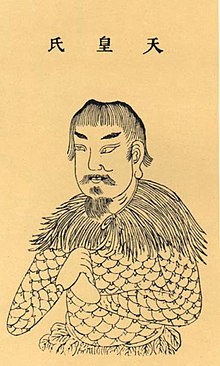Heavenly Sovereign

Portrait of the Heavenly Sovereign
The Heavenly sovereign (Chinese: 天皇; pinyin: Tiānhuáng) was the first Chinese legendary king[1] after Pangu’s era. According to Yiwen Leiju, he was the first of the Three Sovereigns.
Name[]
The book Lushi from the Song Dynasty records that his family name was Wang(望),his given name was Huo(獲) and his courtesy name was Zirun(子潤).[2]
Biography[]
According to the "Basic Annals of the Three Sovereigns" (三皇本紀) in Sima Zhen’s supplement to the Records of the Grand Historian:[3]
- After the Heaven and the Earth were formed, there was Tiānhuáng, who had twelve heads, cast his magic to fill the Earth with water. He lived until the age of 18,000.
- And, Tiānhuáng was a king of many achievements. He lived to 18,000 years old. His twelve children supported him in reigning the world.
- He "lived in retirement, in a state of inaction, converts from the busy world".[N 1]
His greatest achievement was suppressing all the chaos, divided the world for the many tribes, choosing the best persons to rule the tribes.
His successor was the Earthly Sovereign.
According to the Yiwen Leiju,
- Based on Shixue (始學) by Xiang Jun, after the heaven and earth were formed, there was the Heavenly Sovereign, with 13 heads. He was called Tianling (天靈, ‘heavenly spirit’) and ruled the world for 18,000 years.
- Based on Dongming Ji (洞冥記), there were 13 people with the same family name.
- Based on the records in the Three Five Historic Records (三五歷紀) by Xu Zheng, when history began, life started to exist, and there was a divine spirit that had 13 heads called Tianhuang.
- Based on Chunqiu Wei (春秋緯), there were Heavenly, Earthly and Heavenly Sovereigns, they had 9 brothers and divided the world into the Nine Provinces, which spanned the world.
- Based on Dunjiakaishan Tu (遁甲開山圖), the emperor's remains are said to be under the Kunlun in Zhuzhou (柱州).
See also[]
References[]
- ^ a b . Translated by Allen, Herbert J. "Ssŭma Ch'ien's Historical Records, Introductory Chapter". Journal of the Royal Asiatic Society. 26 (2): 269–295. 1894. doi:10.1017/S0035869X00143916.
- ^ "路史卷二". ctext.
- ^ Sima Zhen. 補史記 (Supplement to the Records) (second-to-last paragraph)
Categories:
- Three Sovereigns and Five Emperors
- Chinese monarchs
- Legendary rulers